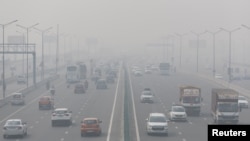The Indian capital will close primary schools starting Saturday in the latest emergency measure taken by authorities in a city shrouded for days in toxic gray smog.
As air quality levels plunged to levels considered “severe,” authorities have halted construction work to curb dust pollution, stopped trucks running on diesel from entering the city and deployed anti-smog guns — devices that spray a mist of water into the air to bind dust and air-borne particles.
Delhi’s Chief Minister Arvind Kejriwal said the government would also consider restrictions on road traffic to lower pollution levels. Half the government staff will work from home.
The deadly smog that envelops Delhi and surrounding regions every winter is a mix of car exhaust, construction dust and industrial emissions that hang low as wind speeds and temperatures drop. It becomes deadlier as winds blow smoke into the city from fires that farmers in neighboring states set to paddy straw at this time of the year to clear their fields for planting wheat.
The decision to shut down primary schools and to restrict outdoor activity for older students came amid growing demands from environmentalists and parents as the air quality level hit 470, which is nearly five times the global safety standards.
“Delhi is on fire right now, and it is only going to get worse over the next week. There is immediate need for emergency action until the situation improves because children are the most vulnerable,” said environmentalist Vimlendu Jha, founder of Swechha, a regionally based non-profit that works on environmental and youth issues. "And in the long term, we have to expand public transport so that we reduce the 15 million private vehicles on the road. Mobility cannot be private."
In the city of 20 million, as many residents battled health problems caused by breathing the toxic air, the inevitable question was raised: Why is the Indian capital unable to tackle the pressing problem?
Experts said the city is losing the battle against the deadly haze that reappears every winter despite significant measures, such as shutting down coal-based power plants and switching to clean fuel for industries, largely because of its huge reliance on private transport and failure to end the burning of crop stubble.
Many of Delhi’s residents rely on private vehicles that include cars, motorcycles and auto rickshaws for their daily commute.
According to a recent study by the Delhi-based Center for Science and Environment (CSE), these vehicles have emerged as the biggest contributor among local sources of the winter haze in Delhi, accounting for almost 50% of the pollution.
“While the need is to scale up public transport, when you look at the actual investments in the city, the focus has been on building more roads — bigger roads, flyovers, overpasses and underpasses — to facilitate vehicular movement but not on improving the bus system to make it easily accessible for everyone,” said Anumita Roychowdhury, CSE’s executive director for research and advocacy. “And there has been virtually no effort to make paths for pedestrians or cyclists.”
Delhi’s battle with dirty air is complicated by its proximity to vital economic sectors such as agriculture that are also major sources of pollution. Neighboring Punjab and Haryana states, from where the farm fires emanate, are known as the bread baskets of India and critical to food security.
Although the government has made efforts to promote subsidized machines that get rid of crop fodder, many farmers still prefer to set the stubble ablaze, which they say is cheaper and quicker. A ban on crop burning is seldom enforced in states where farmers are a huge voting bloc.
In Punjab, the number of farm fires increased by nearly 20% over the last year, leading to a political blame game between the local government in Punjab and the federal government.
“There is no doubt over who has turned Delhi into a gas chamber,” Environment Minister Bhupender Yadav tweeted Wednesday.
Farmers in Punjab said it will take time for millions of small farmers to switch from the way in which they have been disposing of their crop stubble for decades.
“Sometimes farmers don’t have time to wait for planting the next crop, so burning is an easy solution,” said Puneet Singh, who farms a four-hectare spread in Punjab. “On the machine, you need two or three operations to deal with the rice straw, so it takes more time, and it is also more expensive. While educated ones now understand that burning stubble is not good for the ecosystem, many others feel it is not fair to blame their fires for the pollution in Delhi.”
He said he has used the machine that cuts the rice straw and sows wheat seeds and found it to be efficient.
Environmentalists point out that while much of the focus remains on pollution levels in the Indian capital, it is a problem that many other cities in the country confront.
Besides Delhi, much of North India also suffers from severe levels of air pollution.
“So far, clean air has not become an electoral issue in the country. Unless that happens, governments will not take the hard decisions that are needed to address the problem,” said Roychowdhury. “We need to focus a lot more on building awareness so that public demand for tackling air pollution builds up.”







